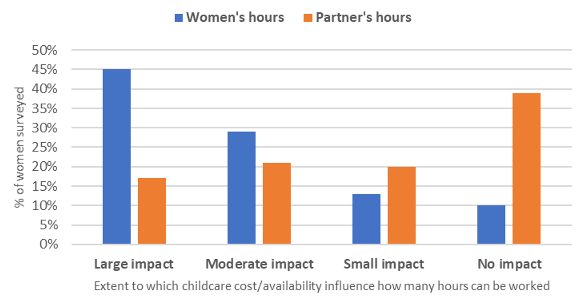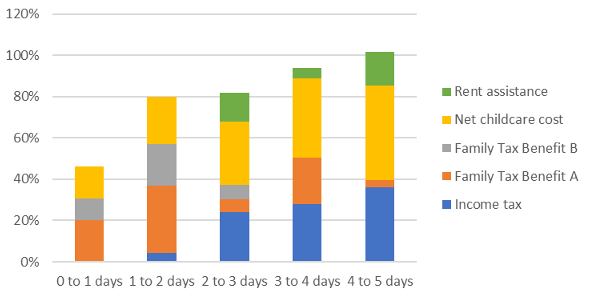-
Recent Commonwealth and State budget childcare reforms aim to not only increase women’s workforce participation but also soften the blow of increasing costs of living.
They also make sense given the impacts of ongoing labour shortages resulting from the COVID pandemic’s disruption of immigration and the global demand for workers.
“Women returning to the workforce face a multifaced challenge. Encouraging females into the workforce is not a ‘nice to have’, it’s an economic imperative.”
According to the Australian Bureau of Statistics, net migration fell last year by about 90,000 people. There are 500,000 fewer temporary migrants and half as many international students in Australia now compared with 2019.
But there are 400,000 job vacancies, the highest level on record and almost double pre-pandemic levels.
Meanwhile, a demographic shift is seeing baby boomers (aged 57 – 76), the second-largest population demographic, retiring with further significant impact on the workforce.
In last month’s Commonwealth budget, the Treasurer Jim Chalmers announced funding of $4.6 billion over four years that will go some way to making childcare more affordable for a wider range of families earning less than $530,000.
The Child Care Subsidy (CCS) for eligible families will increase up to 90 per cent (for those earning less than $80,000), with the CCS rate tapering down by 1 percentage point for each additional $5,000 in income beyond $80,000. Families with a second (and subsequent) child in care aged 5 and under will benefit from CCS rates of up to 95 per cent.
Positive reforms
Earlier in the year the New South Wales government announced significant investment to support women’s economic empowerment, including funding for childcare and early childhood education to help alleviate cost-of-living pressures.
Two key elements include funding of $5 billion over 10 years for 47,000 extra childcare places and the introduction of universal pre-kindergarten for all children in NSW by 2030. These reforms will see 95,000 women enter the workforce or increase hours worked over the next 10 years
Meanwhile the Victorian government has said it will invest $9 billion over the next decade to overhaul the state’s early childhood education and care, including making kindergarten free across the state, offering a year of universal pre-prep and establishing 50 government-operated childcare centres.
Like the childcare centre industry and parents using childcare, we welcome these reforms. As healthcare bankers we maintain strong support for investment in the childcare sector and any reforms which make it easier for women to return to work without adding further financial burden.
Impact of childcare cost and availability on women's working hours
{CF_IMAGE}
Future directions?
Finding adequate skilled employees for childcare centres is a key challenge. The latest National Skills Commission report found childcare workers are in national shortage with vacancies hitting a record of more than 6,200 in March.
When the increase in CCS rates is implemented in July 2023 it should reduce household childcare expenses and support ongoing demand for childcare places. This is in turn will support women’s workforce participation and by extension the country’s economic growth.
Inflation is at a higher level now but, assuming it declines as Treasury expects, history suggests we could see a game of catch-up as costs and childcare prices increase with assistance payments to families lagging.
At some point in a dual-income household, especially those working in metropolitan areas with higher costs, it may not make financial sense for both parents to return to work given the cost burden of childcare.
Workforce disincentive rate for a second earner
(who has $60k full-time earnings){CF_IMAGE}
With that in mind, we also await the recommendations from the Australian Competition and Consumer Commission (ACCC) inquiry into childcare costs. What reforms might the ACCC consider outside increases to the CCS?
Issues with childcare preventing parents who want to work more
{CF_IMAGE}
Could the inquiry spur a conversation about what employers might do? For example, there are opportunities for both promoting return to the office and supporting childcare needs through converting unused office space into on-site childcare, subsidised by the employer as an employee benefit. This would surely entice women back to the workforce with the support they need to succeed.
Diversity measures at senior levels of corporate organisations are still lagging. They need to go beyond the traditional measurements of “women in management” percentages and must support women in their growth years when they need extra support. With that support, we’re likely to see more women experience less time out of the workforce and reduced financial pressure at home.
Childcare is just one aspect
Women returning to the workforce face a multifaced challenge. Encouraging females into the workforce is not a “nice to have”, it’s an economic imperative.
Increasing women’s presence in the workforce represents “one of the biggest economic growth opportunities for Australia,” according to the Grattan Institute which estimates a 2 per cent increase in women’s full-time workplace participation would deliver an $11 billion boost to gross domestic product.
Various studies point to organisations with greater gender diversity realising benefits including increased revenue, better decision making for customers and overall outperformance.
Difference in likelihood of outperformance between
bottom and top-performing companies{CF_IMAGE}
Promoting gender diversity at the enterprise level requires flexibility and formal and informal strategies to support women through different phases of their working life.
We are seeing broader support of women on their maternity leave journey, reshaping approaches to flexible work especially in client-facing roles and providing staff with an opportunity to participate in mentor/mentee relationships across different geographies and business units.
There’s no silver bullet for the thorny issues around childcare affordability and boosting women’s participation in the workforce—but there’s definitely some progress and still more to come.
Cindy Arthur is Head of Health at ANZ Australia Commercial and Brendan Rinaldi is Head of Health at ANZ Institutional.
The views and opinions expressed in this communication are those of the author and may not necessarily state or reflect those of ANZ.
-
-
-
-
anzcomau:Bluenotes/business-finance,anzcomau:Bluenotes/global-economy,anzcomau:Bluenotes/workplace-diversity
Investing in childcare—and boosting women’s participation in the workforce
2022-11-10
/content/dam/anzcomau/bluenotes/images/articles/2022/October/Screen Shot 2022-11-10 at 10.33.47 am.png
EDITOR'S PICKS
-
Families, health, housing and the environment – find the highlights of this year’s Budget in this easy-to-read infographic.
26 October 2022 -
ANZ Chief Economist explains how the ALP government has taken advantage of its first Budget to reset the parameters, the narrative and the framework of Australia’s economic story.
26 October 2022




